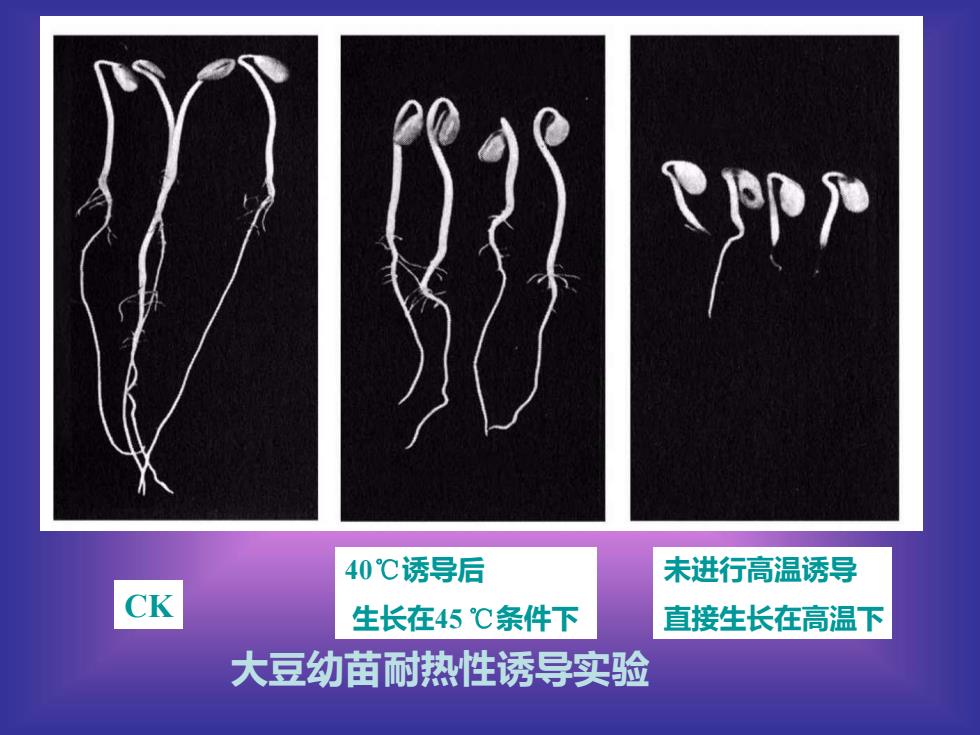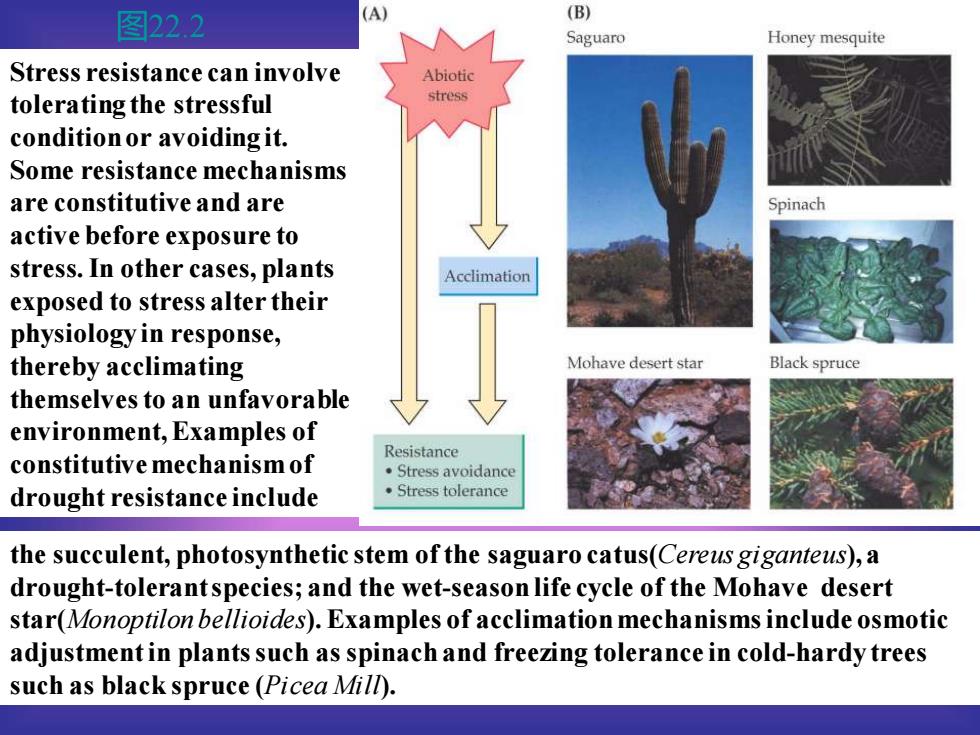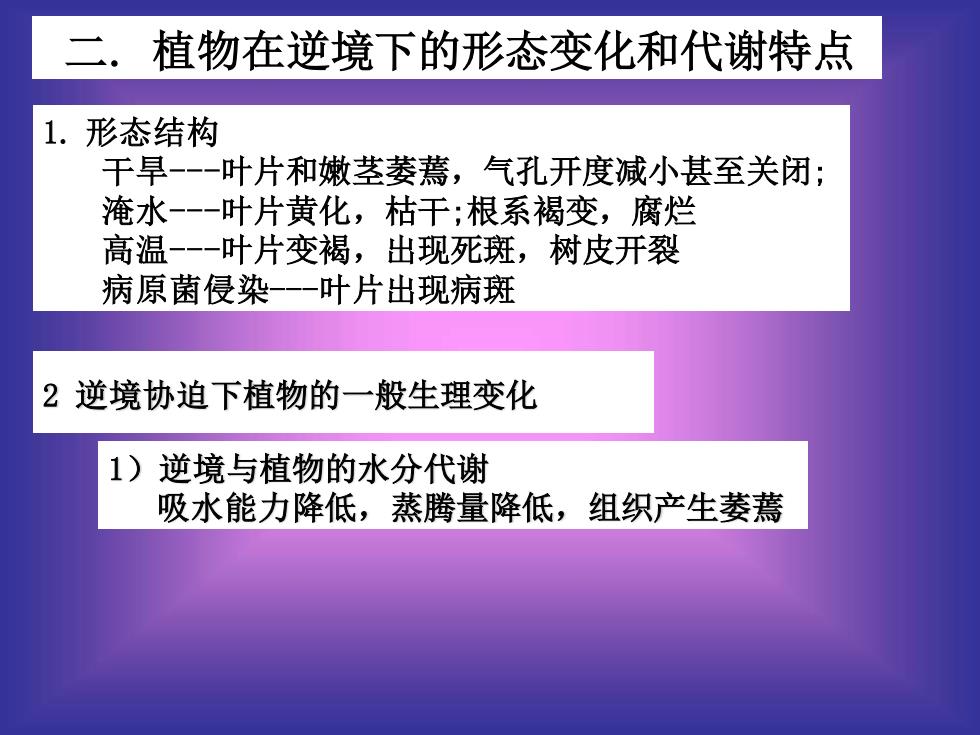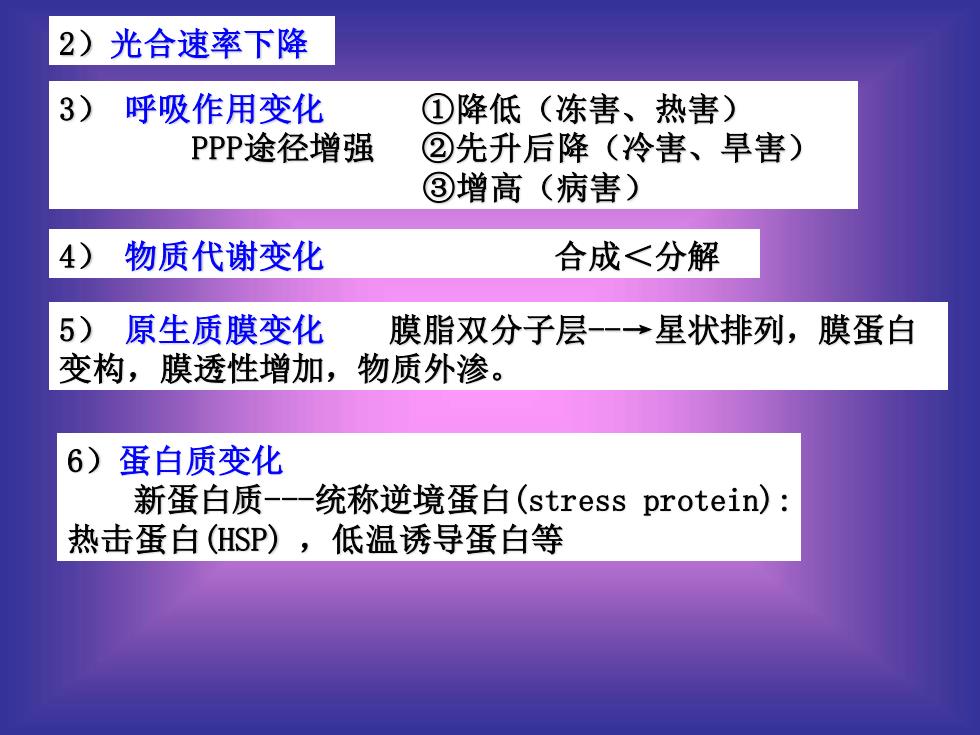
大豆幼苗耐热性诱导实验 CK 40℃诱导后 生长在45 ℃条件下 未进行高温诱导 直接生长在高温下
大豆幼苗耐热性诱导实验 CK 40℃诱导后 生长在45 ℃条件下 未进行高温诱导 直接生长在高温下

图22.2 Stress resistance can involve tolerating the stressful condition or avoiding it. Some resistance mechanisms are constitutive and are active before exposure to stress. In other cases, plants exposed to stress alter their physiology in response, thereby acclimating themselves to an unfavorable environment, Examples of constitutive mechanism of drought resistance include the succulent, photosynthetic stem of the saguaro catus(Cereus giganteus), a drought-tolerant species; and the wet-season life cycle of the Mohave desert star(Monoptilon bellioides). Examples of acclimation mechanisms include osmotic adjustment in plants such as spinach and freezing tolerance in cold-hardy trees such as black spruce (Picea Mill)
图22.2 Stress resistance can involve tolerating the stressful condition or avoiding it. Some resistance mechanisms are constitutive and are active before exposure to stress. In other cases, plants exposed to stress alter their physiology in response, thereby acclimating themselves to an unfavorable environment, Examples of constitutive mechanism of drought resistance include the succulent, photosynthetic stem of the saguaro catus(Cereus giganteus), a drought-tolerant species; and the wet-season life cycle of the Mohave desert star(Monoptilon bellioides). Examples of acclimation mechanisms include osmotic adjustment in plants such as spinach and freezing tolerance in cold-hardy trees such as black spruce (Picea Mill)

避性(escape) 御性(avoidance) 耐性(tolerance) 但这种耐性有一定的限度。 植物对逆境的适应与抵抗方式 植物整个生长发育过程不与逆境相遇 ,逃避逆境危害。 植物具有防御逆境的能力,以抵御逆 境对植物的有害影响,使植物在逆境 下仍维持正常生理状态。(逆境排外) 植物可通过代谢反应阻止、降低或修复由 逆境造成的损伤,使其在逆境下仍保持正 常的生理活动。(逆境存在于细胞内)
避性(escape) 御性(avoidance) 耐性(tolerance) 但这种耐性有一定的限度。 植物对逆境的适应与抵抗方式 植物整个生长发育过程不与逆境相遇 ,逃避逆境危害。 植物具有防御逆境的能力,以抵御逆 境对植物的有害影响,使植物在逆境 下仍维持正常生理状态。(逆境排外) 植物可通过代谢反应阻止、降低或修复由 逆境造成的损伤,使其在逆境下仍保持正 常的生理活动。(逆境存在于细胞内)

二. 植物在逆境下的形态变化和代谢特点 1. 形态结构 干旱-叶片和嫩茎萎蔫,气孔开度减小甚至关闭; 淹水-叶片黄化,枯干;根系褐变,腐烂 高温-叶片变褐,出现死斑,树皮开裂 病原菌侵染-叶片出现病斑 2 逆境协迫下植物的一般生理变化 1)逆境与植物的水分代谢 吸水能力降低,蒸腾量降低,组织产生萎蔫
二. 植物在逆境下的形态变化和代谢特点 1. 形态结构 干旱-叶片和嫩茎萎蔫,气孔开度减小甚至关闭; 淹水-叶片黄化,枯干;根系褐变,腐烂 高温-叶片变褐,出现死斑,树皮开裂 病原菌侵染-叶片出现病斑 2 逆境协迫下植物的一般生理变化 1)逆境与植物的水分代谢 吸水能力降低,蒸腾量降低,组织产生萎蔫

3) 呼吸作用变化 ①降低(冻害、热害) PPP途径增强 ②先升后降(冷害、旱害) ③增高(病害) 4) 物质代谢变化 合成<分解 5) 原生质膜变化 膜脂双分子层-→星状排列,膜蛋白 变构,膜透性增加,物质外渗。 6)蛋白质变化 新蛋白质-统称逆境蛋白(stress protein): 热击蛋白(HSP) ,低温诱导蛋白等 2)光合速率下降
3) 呼吸作用变化 ①降低(冻害、热害) PPP途径增强 ②先升后降(冷害、旱害) ③增高(病害) 4) 物质代谢变化 合成<分解 5) 原生质膜变化 膜脂双分子层-→星状排列,膜蛋白 变构,膜透性增加,物质外渗。 6)蛋白质变化 新蛋白质-统称逆境蛋白(stress protein): 热击蛋白(HSP) ,低温诱导蛋白等 2)光合速率下降